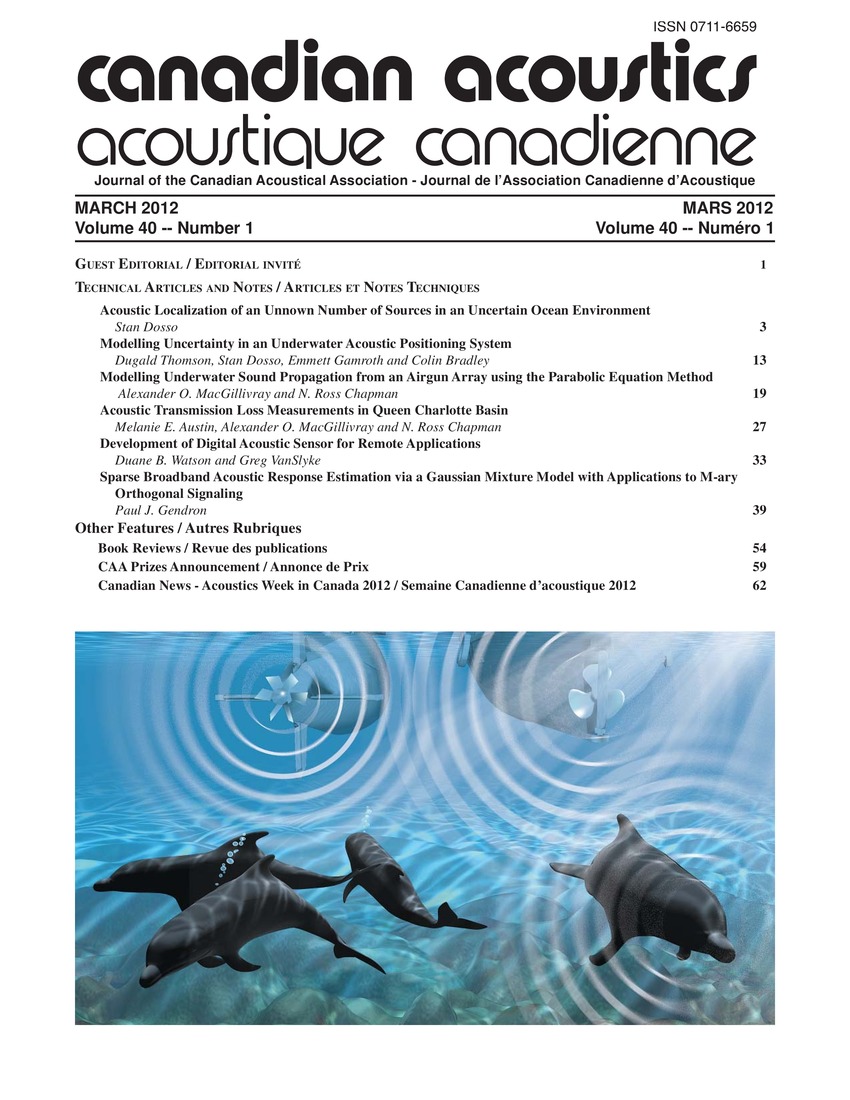Acoustic transmission loss measurements in queen charlotte Basin
Keywords:
Acoustic wave propagation, Forecasting, Acoustic transmission loss, Air guns, Airgun array, Bottom-mounted hydrophones, Experimental data, Mid-frequency, Model prediction, Sound level, Sound propagation, Source level, Transmission lossAbstract
A transmission loss experiment was carried out during the winter in south Hecate Strait using a small airgun array source. Airgun pulses were recorded at horizontal receiver ranges between 20 m and 10 km using a bottom-mounted hydrophone recorder. Transmission loss values were computed by subtracting measured source levels from received sound levels in 1/3-octave bands. Transmission loss data were compared to predictions from a parabolic-equation (PE) sound propagation model coupled with an airgun array source level model. The measured transmission loss was characteristic of cylindrical spreading, with very little additional loss attributable to non-geometric terms. Mid-frequency (100-400 Hz) sound propagation was found to be best supported by the environment. The PE model predictions showed good agreement with the experimental data.Additional Files
Published
How to Cite
Issue
Section
License
Author Licensing Addendum
This Licensing Addendum ("Addendum") is entered into between the undersigned Author(s) and Canadian Acoustics journal published by the Canadian Acoustical Association (hereinafter referred to as the "Publisher"). The Author(s) and the Publisher agree as follows:
-
Retained Rights: The Author(s) retain(s) the following rights:
- The right to reproduce, distribute, and publicly display the Work on the Author's personal website or the website of the Author's institution.
- The right to use the Work in the Author's teaching activities and presentations.
- The right to include the Work in a compilation for the Author's personal use, not for sale.
-
Grant of License: The Author(s) grant(s) to the Publisher a worldwide exclusive license to publish, reproduce, distribute, and display the Work in Canadian Acoustics and any other formats and media deemed appropriate by the Publisher.
-
Attribution: The Publisher agrees to include proper attribution to the Author(s) in all publications and reproductions of the Work.
-
No Conflict: This Addendum is intended to be in harmony with, and not in conflict with, the terms and conditions of the original agreement entered into between the Author(s) and the Publisher.
-
Copyright Clause: Copyright on articles is held by the Author(s). The corresponding Author has the right to grant on behalf of all Authors and does grant on behalf of all Authors, a worldwide exclusive license to the Publisher and its licensees in perpetuity, in all forms, formats, and media (whether known now or created in the future), including but not limited to the rights to publish, reproduce, distribute, display, store, translate, create adaptations, reprints, include within collections, and create summaries, extracts, and/or abstracts of the Contribution.


